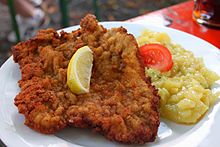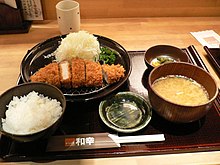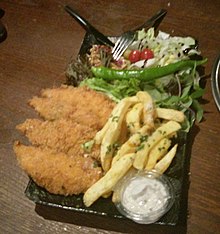
A | B | C | D | E | F | G | H | CH | I | J | K | L | M | N | O | P | Q | R | S | T | U | V | W | X | Y | Z | 0 | 1 | 2 | 3 | 4 | 5 | 6 | 7 | 8 | 9
 | |
| Type | Cutlet |
|---|---|
| Place of origin | Germany |
| Region or state | Central Europe |
| Main ingredients | Meat |
| Ingredients generally used | Breading Fat |
| Variations | Wiener schnitzel |
Schnitzel (German: [ˈʃnɪt͡sl̩] ) is a thin slice of meat. The meat is usually thinned by pounding with a meat tenderizer. Most commonly, the meat is breaded before frying. Breaded schnitzel is popular in many countries and is made using veal, pork, chicken, mutton, beef, or turkey. Schnitzel originated as wiener schnitzel and is very similar to other breaded meat dishes.
Etymology
The German word schnitzel (Middle High German: snitzel) is a diminutive of sniz, 'slice'.[1] The name Wiener schnitzel is first attested in 1845.[2]
Wiener schnitzel

Wiener schnitzel is a popular Viennese dish made of veal and traditionally garnished with a slice of lemon and either potato salad or potatoes with parsley and butter.
In Austria and Germany, Wiener Schnitzel must be made of veal.[3] When other meats are used, it can be called Wiener Schnitzel vom Schwein/Pute/Huhn ("Viennese schnitzel of pig/turkey/chicken") or Schnitzel (nach) Wiener Art ("Schnitzel Viennese style").
Schnitzels worldwide
The English term schnitzel means in general all types of breaded, fried flat pieces of meat. Due to the similarity between schnitzel and escalope, in many of the countries listed below, people sometimes refer to schnitzels as escalope, and vice versa.
Africa
Egypt
In Egypt, there are two dishes similar to schnitzel, one made with chicken and the other with veal. When chicken, it is called "frakh pané" or "فراخ بانى" and is also popular with French fries, in sandwiches, or eaten alone as an appetizer. Using veal, it is called "boftik" or "بفتيك".
Namibia
Schnitzel, both chicken and pork, is common in Namibia due to the country's German colonial history. A majority of the restaurants in Windhoek, Walvis Bay, and Swakopmund offer it on their menus, often topped with a fried egg and accompanied by potato salad. It is often eaten in a Brötchen (German sandwich roll) with tomatoes, cheese, and other dressing.
South Africa
Schnitzel is popular in South Africa, due to the European settlement during the colonial era. Chicken schnitzels and cordon bleu schnitzels are a common item on most restaurant menus and hospitals, and in recent years, beef and pork schnitzels have also become widely available.
Asia
Japan

Japanese tonkatsu (豚カツ, lit. "pork cutlet") consists of a flattened pork loin, lightly seasoned, coated in flour, dipped in beaten egg, coated with panko crumbs and deep fried. Tonkatsu is often served as an accompaniment to ramen or udon or featured with curry and rice.
Pork tonkatsu was invented in Japan in 1899 at the Rengatei restaurant in Tokyo.[4][5][6] It was originally considered a type of yōshoku—Japanese versions of European cuisine invented in the late 19th and early 20th centuries—and was called katsuretsu (cutlet) or simply katsu.[7] Variations include the use of pork fillet (hirekatsu), chicken (chicken katsu), beef (gyūkatsu), ham (hamukatsu) and minced meat (menchi-katsu).
Korea
In Korean cuisine, pork (donkaseu, from Japanese tonkatsu), chicken (chikinkaseu), and beef (bipkaseu) cutlets are popular. The most common types of donkaseu are "kyeongyangsik" (경양식; Western-style) and "ilbonsik"(일본식; Japanese-style).
Europe
Austria
Wiener schnitzel, a very thin, breaded and pan fried cutlet made from veal, is one of the best known specialities of Viennese cuisine, and is one of the national dishes of Austria.[8][9] Wiener schnitzel with sauce is considered unacceptable in Austrian culture.[10]
Popular unbreaded variants in Austria are:
- Jägerschnitzel ('hunter's schnitzel') is a schnitzel with mushroom sauce.
- Rahmschnitzel ('cream schnitzel') is a schnitzel with a cream sauce, often containing some mushrooms.
- Zigeunerschnitzel ('Gypsy schnitzel') is a schnitzel with a zigeuner sauce containing tomato, bell peppers, and onion slices.
Bosnia and Herzegovina
In Bosnia and Herzegovina, the dish is called bečka šnicla or bečki odrezak (bečki = "Viennese"; šnicla = transliteration of German Schnitzel) and is made of veal or beef and usually served with mashed potatoes. Common garnishes include a slice of lemon or some lettuce.
Bulgaria
Called шницел (shnitsel), it is made from ground veal, formed as a thin patty, seasoned with salt and black pepper, then breaded and fried. The dish usually is served with a choice of mashed or roasted potatoes, French fries, or simply a tomato salad. It is common at truck stops, and it is usually ordered à la carte, coming with a lemon wedge, but one can also find it in the frozen sections in supermarkets or premade and ready to cook.
Croatia
In Croatian, the dish is called bečki odrezak (or šnicl) (bečki = "Viennese"; šnicl = transliteration of German Schnitzel) and it is made of veal (sometimes substituted with cheaper pork) and served with French fries or potato salad and a slice of lemon. A similar dish is called zagrebački odrezak (šnicl) (a variation on cordon bleu).
Czech Republic
Schnitzel is also very popular in the Czech Republic, where it is known as a smažený řízek or just řízek, and is made of pork, chicken, or veal. It is often served with boiled or mashed potatoes or potato salad. It also used to be and to some degree still is a typical packed lunch for day trips, when it was consumed with bread (often between two slices of bread as a sandwich)
Denmark
In Denmark, the dish is called skinkeschnitzel when made of pork and wienerschnitzel when made of veal, and is usually served with fried potatoes, gravy, green or snow peas, and a "boy" (dreng in Danish) consisting of a lemon slice topped with capers, horseradish, and a slice of anchovy.
Estonia
In Estonia, schnitzels (šnitsel) are commonly made with pork. There also exists a schnitzel made from cheese that has been breaded and fried, typically served with salad.
Finland



In Finland, the dish called Wieninleike ("Viennese cutlet"), is almost always made of pork, breaded and fried like the original. It is usually served with French fries, potato mash, or wedge potatoes. A slice of lemon, a slice of anchovy, and a few capers are placed on top of the cutlet. Usually, the dish includes a small amount of salad made from fresh vegetables. The dish was popular between the end of the Second World War and the 1990s, when it could be found in most low-end restaurants in Finland. In past decades, it has been overtaken in popularity by fast food.
Wieninleike and its variations remain a staple of menus in many non-ethnic or fine dining restaurant in Finland. Lunch restaurants, highway rest stops and restaurants attached to gas stations are most prominently associated with this type of menu in Finland.
- Wieninleike ("Viennese cutlet") served typically with slice of lemon, anchovy, and caper
- Floridanleike ("Floridian cutlet") served with fried peach and served with Béarnaise sauce
- Havaijinleike ("Hawaiian cutlet") served with fried pineapple
- Holsteininleike ("Holstein cutlet") served with egg, anchovy, and caper
- Metsästäjänleike ("hunter's cutlet") served with mushroom sauce
- Oskarinleike ("Oscar's cutlet") served with choron-sauce, shrimps or lobster, and asparagus
- Oopperaleike ("opera cutlet") served with fried egg
- Sveitsinleike ("Swiss cutlet") is filled with smoked ham and Emmentaler cheese
Typically the dishes above are prepared from pork.
France
Pariser schnitzel is similar to Wiener schnitzel but is floured and fried in an egg batter instead of using breadcrumbs.
Côtelette Menon[11] or Côtelette révolution[12] made of veal and breaded.

Germany
In Germany, the term Schnitzel means cutlets in general, not just breaded, fried ones.
- Schnitzel Wiener Art ('Viennese style schnitzel') is a pounded, breaded and fried cutlet, more often made of pork than of veal. Restaurants mostly serve it with a slice of lemon and french fries.
- Jägerschnitzel ('hunter's schnitzel') is a schnitzel with mushroom sauce. An East German variant of Jägerschnitzel is made of Jagdwurst sausage and without sauce.
- Zigeunerschnitzel ('Romani schnitzel') is a schnitzel with a zigeuner sauce containing tomato, bell peppers, and onion slices. This schnitzel is also called Paprikaschnitzel ('bell pepper schnitzel'), Schnitzel Balkan-Art ('Balkan-style schnitzel') or Schnitzel Budapester Art ('Budapest-style schnitzel').
- Rahmschnitzel (cream schnitzel) is a schnitzel with a cream sauce.
- Münchner Schnitzel ('Munich schnitzel') is a variation on Wiener schnitzel prepared with horseradish or mustard before coating in flour, egg and bread crumbs.
- Schnitzel Holstein, topped with an egg sunny side up.
Hungaryedit

Due to the strong Austrian influence of the Austro-Hungarian era, Wiener schnitzel is popular in Hungary, known as bécsi szelet[13] (Viennese slice), borjú bécsi (Viennese veal) or rántott hús (breaded meat). It is served in restaurants, and is a common meal in Hungarian homes. It is typically served with French fries, mashed potatoes, or rice. Alternatively, green peas or other vegetables are used as a side dish. Bread and salad (or pickles) often accompany the meal. Some restaurants offer the cordon bleu variant, a slice of schnitzel rolled and filled with cheese and ham.
Italyedit
In Italy, there is a similar dish called cotoletta. Cotoletta is very similar to the Austrian Wiener Schnitzel. The Italian veal Scaloppine is also somewhat similar although the meat is not breaded.
Netherlands and Belgiumedit
In the Netherlands (and Belgium) schnitzel is mostly made of pork and served with fries and vegetable salad. Zigeunerschnitzel (served with paprika) and Cordon bleu (Blue ribbon) are very popular. A typical Dutch variant is the 'gehaktschnitzel', a schnitzel made of minced meat. In the Netherlands, every butcher has his own variants.
North Macedoniaedit
In the Republic of North Macedonia, the dish called шницла (shnitzla) is a piece of pork seasoned with salt and black pepper, breaded and fried. Typically, it is served with mashed or fried potatoes with green salad garnish.
Polandedit
Kotlet schabowy is a classical and most popular recipe for boneless pork chop or pork tenderloin. It can also be made from chicken, which is called "Kotlet drobiowy".
Portugaledit
In Portugal, schnitzel is called bife panado or just panado ("breaded"). Different varieties of panado can be made with chicken (panado de frango), turkey (panado de peru), pork (costeleta panada for pork chop, febra panada for pork without bone), or veal (escalope de vitela panado). The meat is usually seasoned with black pepper, garlic, and lemon juice. It is commonly served with spaghetti, fried potatoes, or rice (plain or with beans). It is also popular as a sandwich, served in a bun with lettuce (sandes de panado).
Romaniaedit
Romanian șnițel[14] (pronounced ['ʃni.t͡sel]) is very common in restaurants, fast-food places, and homes across the country. Normally served with french fries, mashed potatoes, or rice, and a slice of lemon or some salad, the fast food version is differentiated by being served sandwich/burger style. Cordon bleu șnițel (made from pork loin stuffed with cheese and ham) is also very popular. The Romanian șnițel is made in the same manner as the Austrian one, but as a local characteristic is made of almost any type of meat (chicken, pork, veal or beef).
A specialty from western Romania is the mosaic șnițel made of two thin meat layers (usually each layer of different meat) and a vegetable (usually mushroom) filling. Also a recipe for șnițel de ciuperci, a mushroom fritter, is common.
Russiaedit
In Russia, the dish is called отбивная (otbivnaya), which literally means a piece of meat that has been beaten, although the name шницель (šnitselʹ) is also in use. Russian cuisine includes recipes of schnitzel prepared from pork, as well as beef, veal, and chicken.
Serbiaedit
In Serbia, the dish is called bečka šnicla (Viennese schnitzel). A local urban legend states the dish originated in Serbia and not in Austria, but no one can say why. In Serbia, the word Schnitzel is used to describe any cutlet, not just breaded meat.
Slovakiaedit
Schnitzel is highly popular in Slovakia, a country bordering Austria, where it is referred to as vyprážaný rezeň. or simply rezeň (in the Western parts of the country, especially in Bratislava, colloquially also schnitzel, or šniceľ). It is often made of pork or chicken, and is typically served with fried potatoes (not peeled), boiled potatoes, mashed potatoes, fries (especially in canteens), potato salad, or rice.
Sloveniaedit
German Schnitzel translates to Slovene as zrezek thus Wiener Schnitzel is called dunajski zrezek (Vienna is Dunaj in Slovenian). As in Austria a real dunajski zrezek is made of veal. Restaurants serving the dish can be found throughout the country, though typically it is made of pork or chicken. Dunajski zrezek is usually served with fried or roasted potato and a slice of lemon. Less popular is pariški zrezek which is prepared the same way but with no breadcrumbs. In Slovenia, a schnitzel filled with ham and cheese, breaded and fried (cordon bleu) is called ljubljanski zrezek (after Ljubljana, the country's capital). Zrezek can also be grilled, fried, braised or pot roasted.
Spainedit
Schnitzel in Spain is Escalope or Escalopa. San Jacobo (commonly) or cachopo (in northern Spain) is usually made with veal or pork stuffed with ham and cheese. For generations it was enjoyed, together with potato omelettes, on family picnics in the countryside.
Swedenedit
In Sweden, the dish is called schnitzel or Wienerschnitzel, and is made most commonly of pork, and is often decorated with a caper-filled circle of either genuine anchovies or the Swedish "fake" ansjovis (made of brine-cured sprats). It is served with rice, fries, or boiled potatoes, and green peas.
Switzerlandedit
Schnitzel, Schnipo, Wienerschnitzel, and Rahmschnitzel are all popular dishes in Switzerland. Schnipo (a schnitzel and fried potato combination) is quite popular.[15] The Rahmschnitzel version is made with either veal or pork and topped with a cream sauce, sometimes including mushrooms. The cordon bleu variant of schnitzel – two slices of schnitzel (or one with a pocket) filled with cheese, typically Emmentaler or Gruyere, and a slice of ham – is also popular in Switzerland. Also the "Walliser Schnitzel" is a variant in which the meat is not breaded, but is fried in oil and then coated with tomato sauce and raclette cheese.
Ukraineedit
In West Ukraine (former Habsburg Kingdom of Galicia and Lodomeria), it is known as шніцель shnitsel′; in the rest of the country, it is called as відбивна vidbyvna, also bytky. It is usually made of pork, or sometimes chicken.
United Kingdomedit
The parmo, or Teesside Parmesan,[16] is a schnitzel popular in Middlesbrough, Teesside, and a popular item of take-away food in North East England. It consists of a breaded cutlet of chicken or pork topped with a white béchamel sauce and cheese, usually cheddar cheese.
Middle Eastedit
Iranedit

Schnitzel is popular in Iran, where it is known as shenitsel (Persian: شنیتسل). Thought to have been introduced in Persia during the World Wars, shenitsel is usually thicker, bigger, spicier, and fried with a more crispy breading than the standard schnitzel. It is customarily served with lemon, French fries, and a variety of boiled vegetables.
Another Iranian dish, kotlet (Persian: کتلت), should not be confused with shenitsel. They are small, oval-shaped patties made by deep-frying a mix of ground meat, onion, potato, and herbs.
Israeledit

In Israel, the dish (Hebrew: שניצל, shnitsel) is a popular food in Israeli cuisine. The meat is typically chicken or turkey breast, in conformance with dietary kashrut laws, which prohibit pork. Additionally, vegetable oils are use for the frying, as clarified butter, the preferred cooking fat for Austrian Wiener schnitzel, is impermissible for kosher use alongside meat. Before frying, the schnitzel is coated with a mixture of beaten eggs and bread crumbs, sometimes spiced with paprika or sesame seeds. It is usually served with mashed potatoes, French fries, rice, or pasta, accompanied by ketchup, hummus, or vegetable salad.
The schnitzel tradition was brought from Europe to Israel by Ashkenazi Jews. During the early years of the state of Israel, veal was not obtainable,[17] and chicken or turkey proved to be inexpensive and tasty substitutes. Packaged schnitzels are widely available in the frozen food section of most supermarkets. Some frozen schnitzels are breaded patties made from processed chicken or turkey meat, not whole poultry breasts. One can also find in the frozen food section Israeli corn schnitzels alongside other vegan options. Schnitzel is also sold in a pita, alongside hummus, French fries and vegetable salad, in a similar way to falafel. Many falafel stands also offer a schnitzel in a pita.
Lebanonedit
In Lebanon, the dish is normally called escalope. Escalope is a French term and is a broader category of beaten, breaded meat of which Schnitzel is a type. While schnitzels are fried, escalopes need not be, even though it most commonly is. Lebanon likely adopted the French term during the French mandate period of Lebanon.
Zdroj:https://en.wikipedia.org?pojem=ȘnițelText je dostupný za podmienok Creative Commons Attribution/Share-Alike License 3.0 Unported; prípadne za ďalších podmienok. Podrobnejšie informácie nájdete na stránke Podmienky použitia.
Antropológia
Aplikované vedy
Bibliometria
Dejiny vedy
Encyklopédie
Filozofia vedy
Forenzné vedy
Humanitné vedy
Knižničná veda
Kryogenika
Kryptológia
Kulturológia
Literárna veda
Medzidisciplinárne oblasti
Metódy kvantitatívnej analýzy
Metavedy
Metodika
Text je dostupný za podmienok Creative
Commons Attribution/Share-Alike License 3.0 Unported; prípadne za ďalších
podmienok.
Podrobnejšie informácie nájdete na stránke Podmienky
použitia.
www.astronomia.sk | www.biologia.sk | www.botanika.sk | www.dejiny.sk | www.economy.sk | www.elektrotechnika.sk | www.estetika.sk | www.farmakologia.sk | www.filozofia.sk | Fyzika | www.futurologia.sk | www.genetika.sk | www.chemia.sk | www.lingvistika.sk | www.politologia.sk | www.psychologia.sk | www.sexuologia.sk | www.sociologia.sk | www.veda.sk I www.zoologia.sk
